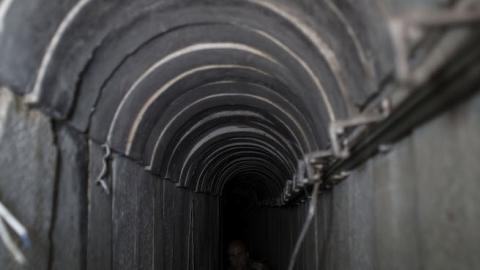During the first two weeks of the Gaza conflict, Hamas landed at least two significant punches. In firing missiles at Ben Gurion Airport, Hamas convinced the Federal Aviation Authority and European air carriers to temporarily suspend flights to Israel. The fact that relatively primitive rockets falling far short of their targets are nonetheless capable of at least briefly severing an advanced Western democracy with a leading tech economy from the rest of the world is a psychological blow. But perhaps the even greater concern for Israeli officials is the revelation of Hamas’s extensive tunnel network.
Until Operation Protective Edge, it was generally assumed that Gaza’s tunnel system was simply a feeding tube for a community of 1.8 million people. With both the Egyptian and Israeli borders closed, as well as Israel’s naval blockade, goods entered Gaza mainly through the tunnels from Egypt. So did weapons, including missiles made or designed by Iran, which, as the last two weeks have shown, are capable of reaching any site in Israel. The tunnel economy flourished under former Egyptian president and Hamas sponsor Mohamed Morsi but has suffered under his successor, Abdel Fattah al-Sisi, who has won praise from Jerusalem for shutting down as many tunnels as he can find.
However, there is another system in Gaza as well, a network of attack tunnels that end not in Egypt but in Israel, where over the last two weeks Hamas commandos have attempted several terrorist operations.
“Hamas leader Ismail Haniyeh said that we are not under siege, we are imposing a siege,” says retired IDF officer Jonathan Halevi, now a senior researcher at the Jerusalem Center for Public Affairs. “What he meant was that [Hamas] can use tunnels as a strategic weapon. If you multiply tunnels, you can use them to send hundreds of fighters into Israel and create havoc, totally under cover. According to Hamas, the tunnels have changed the balance of power.”
Israeli officials have expressed amazement at the extent of the tunnel network. “Food, accommodations, storage, resupply,” one astonished official told reporters last week. “Beneath Gaza,” he explained, there’s “another terror city.” That is, Hamas’s tunnel network is evidence of a military doctrine, both a countermeasure to Israel’s clear air superiority and an offensive capability that threatens to take ground combat inside Israel itself, targeting villages, cities, and civilians as well as soldiers. Israel perhaps should not have been surprised to discover the size and seriousness of Hamas’s tunnel network because they’ve seen something similar before, in the aftermath of the 2006 war with Hezbollah. And indeed it was Iran’s long arm in Lebanon that helped build Hamas’s tunnels.
“The spiritual father of Hamas’s tunnel system is Imad Mughniyeh,” says Shimon Shapira, a Hezbollah expert and senior research associate at the Jerusalem Center for Public Affairs. Mughniyeh, assassinated in 2008 in an operation believed to have been conducted by the Israelis, is credited with directing Hezbollah’s 2006 war. He was the head of the organization’s external operations unit and responsible for countless terrorist attacks. He also served as liaison to the top Iranian leadership as well as other Iranian allies and assets, including Hamas. “Mughniyeh sent instructors to Gaza and took Hamas members to Iran,” Shapira explains.
While Hamas and Hezbollah’s tunnel technology, equipment, and funding are mostly Iranian, the knowledge and the doctrine date back to the earliest days of the Cold War.
“The North Koreans are the leading tunnel experts in the world,” says North Korea expert Bruce Bechtol. They learned as a matter of necessity. “The U.S. Air Force basically exhausted its target list after the first eight months of the Korean War,” Bechtol explains. “All the North Korean cities were turned to rubble, so they got good at building large tunnels and bunkers, some of them 10 or 11 square miles. In effect, the North Koreans moved their cities underground for three years, with hundreds of thousands of people living down there.”
“There is no better protection than the earth,” says David Maxwell, associate director of the Center for Security Studies at Georgetown University. But Pyongyang also has an offensive doctrine. “Defectors tell us that the North Koreans built 21 tunnels under the demilitarized zone, but only 4 have been discovered,” says Maxwell, a retired U.S. Army colonel who served in South Korea. “Our concern is that the North Koreans would infiltrate, sending thousands of men through the tunnels in an hour, maybe dressed in South Korean uniforms. You can’t imagine the kind of havoc that would wreak.”
Just last week Hamas tried the same tactic, sending commando units disguised as IDF troops through two tunnels. For a short time, they fooled real Israeli soldiers in an observation post.
It’s nothing new for the North Koreans to work with terrorist groups, as Bechtol explains. It started with the Polisario, the North African, and at one time Soviet-funded, terrorist group fighting the Moroccan government. “The North Koreans built them underground facilities, command and control, hospitals,” says Bechtol. “All of it was supported by Soviets, but that changed with the end of the Cold War, when the North Koreans offered their services on a cash and carry basis only.”
Their top customer is the Islamic Republic of Iran. The North Koreans, Bechtol says, have helped build some of the Iranians’ underground nuclear weapons facilities, as well as Hezbollah’s underground network. “They built it in 2003-04, coming into Lebanon disguised as houseboys serving the Iranians. Maybe nobody asked, hey, how come these houseboys are speaking Korean?”
The significance of the tunnels became clear in the 2006 war, as Bechtol explains. “It lowered Hezbollah’s casualty rate. The Israelis wondered why the air force was not inflicting more damage and it was because of those tunnels. It was the first time Hezbollah was ever truly protected.”
Last week a U.S. federal judge ruled that North Korea and Iran were liable for providing support to Hezbollah during the 2006 war. According to U.S. District Judge Royce Lamberth, North Korea and Iran assisted “in building a massive network of underground military installations, tunnels, bunkers, depots and storage facilities in southern Lebanon.” Lamberth noted that one Hezbollah commander who received training in North Korea was Mustafa Badreddine, Mughniyeh’s cousin. And as with North Korea, Hezbollah’s heavily reinforced underground network has also given rise to an offensive doctrine—to invade northern Israel.
“Hassan Nasrallah says Hezbollah has a two-part operational plan,” says Shimon Shapira. “One is rocket fire on Tel Aviv and two is conquest of the Galilee. I wondered what he meant by that—how is Hezbollah going to invade the Galilee, take hostages, capture villages, and overrun military installations? But we’re learning from what is happening now. Nasrallah means Hezbollah is going to penetrate Israel through tunnels.”
The difference between Hamas’s underground network and Hezbollah’s, explain experts, is the topography. It’s easier to dig tunnels in the Gaza sand than in the rocky pastures and rich soil of the Galilee. The catch is that the latter are also harder to destroy since they are further fortified by nature.
Several Israeli journalists are reporting that “the fiasco of the tunnels,” as Yossi Melman calls it, might have been avoided. Either military and security officials were aware of the extent of Hamas’s network and didn’t do enough about it, or they ran up against bureaucratic roadblocks. Whether the IDF needs to detail a specific unit to monitor and uproot the tunnels that cross into Israel on its southern and northern borders, one fact is plain: For decades Israel’s traditional military doctrine has been to fight its enemies on the other side of the wire. However, its enemies’ new North Korean-inspired doctrine is to go under the wire. If Israel doesn’t deal with first Hamas’s tunnels and then Hezbollah’s, the next war it faces may well be inside Israel itself.
















